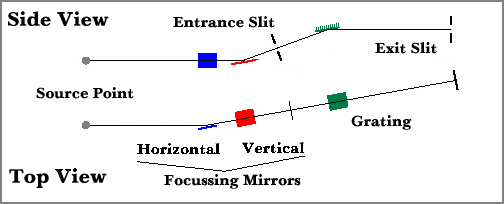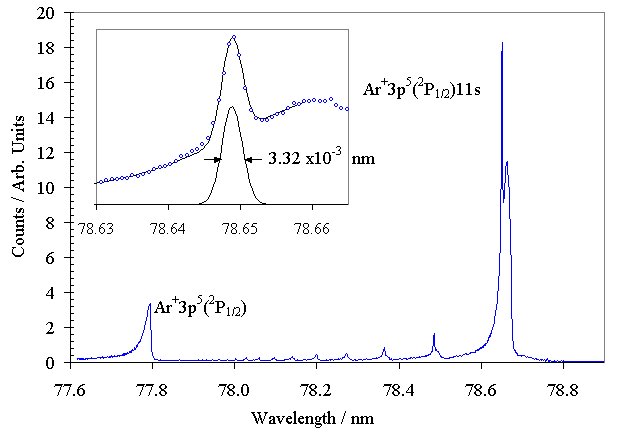The SGM 2 beamline at ASTRID
The SGM2 beam line on ASTRID, commissioned in 1998, was designed to produce high resolution (1 meV) low energy electrons via near-threshold ionisation of argon. It operated to provide a source of low energy (0.005 to 10 V) electrons for gas phase electron-molecule scattering experiments and also in the investigation of a new type of spontelectric material
This beam line was in operation until 2013 and was not transferred onto the new ASTRID2 ring.
The designed photon energy range of SGM2 was 12 to 40 eV using the undulator as the source. The beamline was arranged as follows:
- A spherical horizontally focusing mirror which deflects the SR beam into the SGM II beamline and focuses the source in the horizontal plane at the exit slit position. This is the first optical element the beam encounters, calculations of the heat loading indicated no problems and this mirror is uncooled.
- A spherical vertically focusing mirror to image the source in the vertical plane onto the entrance slit.
- Cooled entrance slit of a continuously variable design over a range of 10 to 400 microns with a change in slope at 200 microns to allow fine adjustment at narrow settings but more rapid adjustment at the wider values.
- A gold coated spherical grating, with a groove density of 450 lines/mm, to provide the required dispersion.
- Translatable exit slit, also continuously variable. Translation is necessary to maintain a correct focus at the exit slit as the monochromator is scanned over a large range of wavelengths. The total travel is 450 cm over the full photon energy range.
- No post-focussing mirror was installed in the beamline. The electron-molecule scattering chamber which was coupled to the exit slit housing had an internal focussing mirror.
A schematic of the optical layout is shown below.

SGM II was designed with a very high
resolving power (R ~ 23,000) at 15.76 eV (786.5 Å), the threshold
for the photoionisation of argon. This decision was taken so as to provide
a high flux of extremely narrow energy spread photoelectrons for use in
an electron-molecule scattering experiment. The monochromator can of course
be used as a source of VUV for other experiments but the resolution achievable
will depend on the output photon energy, becoming worse (R ~ 3,000) at
the highest energies. Calculated and measured resolutions at a photon energy
of 15.76 eV with different slit widths are given in the table below and
a photoionisation spectrum of argon taken with slit widths of 20 microns
shows the typical performance, namely 0.9 meV FWHM or R ~17,500.
| Width (microns) | Calculated (meV) | Measured (meV) |
|---|---|---|
| 10 | 0.67 | 0.67 |
| 20 | 0.9 | 0.9 |
| 30 | 1.2 | 1.3 |
| 40 | 1.5 | 1.6 |

For further information please contact:
Beamline: Søren Vrønning Hoffmann
Electron-Molecule scattering experiment: David Field
Last Modified 30 August 2016